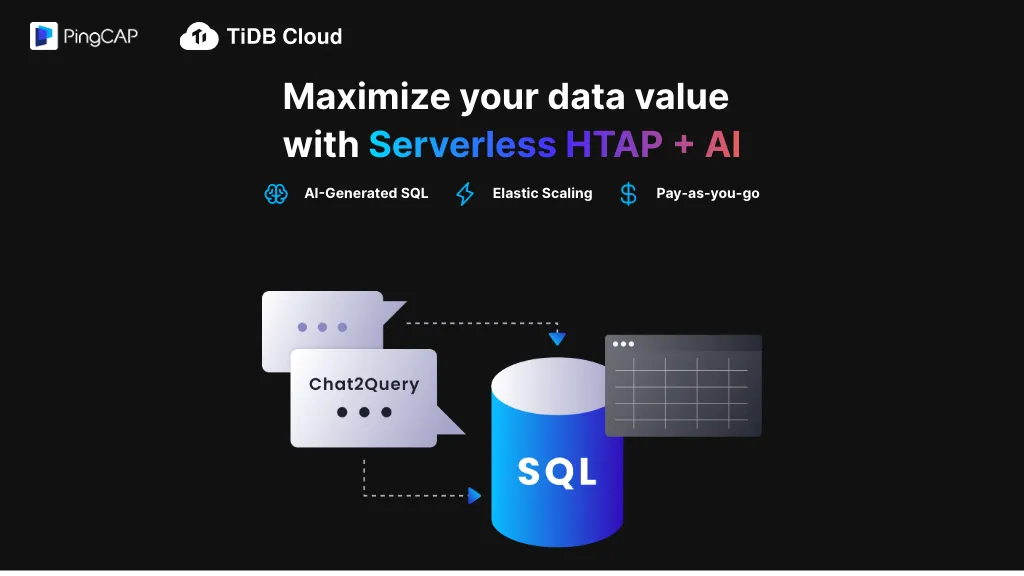What is TiDB?
TiDB is a high-end AI-powered tool that offers serverless, scalable solutions to users. It embeds AI-generated SQL and HTAP in this all-powerful solution, therefore turning quite useful and agile in handling various kinds of data-related activities. It runs on a pay-as-you-go basis; therefore, flexibility and cost come with its usage. Besides, one shared Tidb can be used with a cloud account, and signing up is quite easy by different methods. It has partners like Auth0, Maxim Data, and Valu, which associates with the credibility and wide acceptance of Tidb in the market.
Tidb’s Key Features & Benefits
Tidb is loaded with a lot of features that serve different user needs. Here are the few of its main features:
-
Serverless AI:
No server management involved, reducing the overhead of operations. -
Scalable AI:
The system itself can scale up and down according to the workload, ensuring the best performance all the time. -
AI-generated SQL:
This allows, on the fly, for the generation of SQL queries, leaving complicated data interaction easy. -
HTAP functionalities:
Integrate transactional and analytical processing in a single system with the objective of gaining efficiency in the processing of data. -
Pay-as-you-go model:
In this flexible pricing structure, users have to pay according to their use.
All of these features come with a lot of benefits in reducing operational costs, enhancing efficiency, and improving data processing capability. Unique selling points for TiDB include a serverless and scalable architecture, ensuring continuity in performance without the hassle of infrastructure management.
Tidb Use Cases and Applications
Tidb is a versatile software with applications cutting across many domains. Some specific areas of application include:
-
Data Analysis and Processing:
It allows for the analysis of data at very fast speeds. This quality has led to it being one of the major development tools preferred by data analysts and scientists. -
Real-time Data Processing:
Capable of real-time data streams processing; this makes it very useful in applications where insights have to be gleaned from data in real-time. -
Scalable AI-powered Applications:
This is great for creating applications that need to scale as data and user demands keep getting bigger.
This will significantly enhance the potential of Tidb within industries such as finance, healthcare, and e-commerce. Data analysts, data scientists, business intelligence professionals, developers, and project managers are the primary users utilizing Tidb for the data-centric tasks at hand.
How to Use Tidb
Using Tidb is rather straightforward due to the friendly user interface and since it is based on the cloud. Here is a step-by-step process to get you started:
-
Create an Account:
Sign up to a Tidb cloud account with your preferred signup option. -
Set Up Your Environment:
Configure your workspace in accordance with your project requirements. -
AI-Generated SQL:
Make use of the AI-generated SQL feature. This facilitates ease in data querying. -
HTAP Functionalities:
Make use of the HTAP functionalities for data processing efficiently. -
Monitor and Scale:
Monitor continuously the workloads and scale as per need with the scalable AI feature.
Best Practice:
Always keep your data processes under close monitoring and utilize the pay-as-you-go model in managing its cost.
How Tidb Works
Tidb works with a very advanced technological framework that brings together AI and cloud computing. The core technology involved is:
-
AI Algorithms:
Advanced AI algorithms power the AI-generated SQL, hence powering automated and efficient data querying. -
HTAP Architecture:
HTAP puts transactional and analytical data processing together under one architecture so that it is able to offer incorporating solutions for all kinds of diversified data. -
Scalable Cloud Infrastructure:
The cloud infrastructure being scalable lends power to Tidb for taking care of different data loads without compromising performance.
This generally includes initial data ingestion through AI-generated SQL processing and, after that, the use of HTAP functions for deriving analytical insights all over the data.
Tidb Pros and Cons
It is said that every tool has its advantages and probable pitfalls, and the same holds good for Tidb as well. They are as follows:
-
Pros:
- Serverless architecture means low operational overhead;
- It scales, so it performs well with varying workloads;
- AI-generated SQL makes complex data interactions easy;
- Unified HTAP functionalities in one platform for all data processing tasks;
- Flexible, pay-as-you-go pricing.
-
Cons:
- The initial setup may be pretty complicated and require a learning curve for fresh users;
- Not every organization would be in favor of dependence on cloud infrastructure.
Most feedback from users is related to Tidb’s efficiency and scalability. At the very beginning, a few do mention a learning curve as a minor drawback.
Conclusion about Tidb
Tidb is such an ultra-powerful AI tool: serverless, scalable, AI-generated SQL, and supporting HTAP. Its flexible pay-as-you-go model and advanced features make it a very valuable tool for data analysts, scientists, and business intelligence professionals. Maybe there might be a little learning curve at the beginning, but its benefits far outweigh this tiny disadvantage. Further developments will have even more enhancements, making sure that Tidb stays at the very top of AI-powered data solutions.
Tidb FAQs
Here are some frequently asked questions about Tidb:
-
What is Tidb?
Tidb is an AI serverless with scale, AI-powered SQL, and HTAP features. -
How does Tidb’s pricing work?
Tidb charges on a pay-as-you-go basis. Users only pay for the resources consumed. -
Who can benefit from using Tidb?
Data Analyst, Data Scientist, Business Intelligence Professional, Developers, and Project Managers can all benefit from using Tidb. -
What are some features of TiDB?
Most of the key features include serverless AI, scalable AI, AI-generated SQL, HTAP functionalities, and a pay-as-you-go model. -
What are some of the disadvantages of TiDB?
It has a learning curve for its initial setup, and some organizations just do not like dependence on cloud infrastructure.

